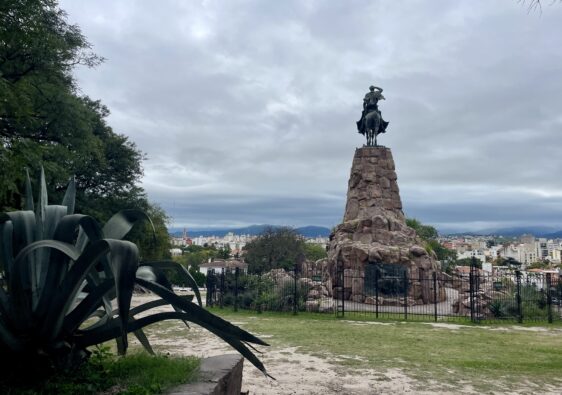Welcome to Argentina’s Incredibly Unique Money Situation
If you’ve been to Argentina, or read the headlines, you know that Argentina has a WILD economic situation. In 2023, Argentina experienced an inflation rate of 211%. For context, a normal inflation rate is 2-4%.
Because of this inflation, exchanging money in Argentina can be tricky. In fact, there are multiple exchange rates used, depending on which method you use. We’ll go over each one that we encountered during our six weeks in Argentina.
Also, if you’re exchanging a currency from a country with a half-decent economic situation AND you can afford to travel to Argentina, you’re extremely lucky. Make sure to tip well, support local businesses, and acknowledge the privileges you have! Tons of people in Argentina have been adversely affected by Argentina’s economic situation. Argentineans were super nice and a huge part of why we had such an amazing time in this beautiful country!
Let’s get into how to exchange money in Argentina!
Please note that some of the links below may be affiliate links, and at no additional cost to you, we earn a commission if you make a purchase.
What is the Best Way to Exchange Money in Argentina?
The best way to exchange money in Argentina is sending yourself money through Western Union before your trip. Western Union has the best exchange rate, and even with their fees (which you can avoid the first time), it can be worth it. Here are the next best ways to exchange money/pay in pesos, and their % rate less than Western Union’s rate:
- With 100-dollar US bills in good condition (11% less than Western Union rate)
- Paying with a visa credit card (12% less than Western Union rate)
- Using a debit card to withdraw pesos at ATMs (16% less than Western Union rate)
- Exchanging 20-dollar US bills (21% less than Western Union rate)
- Exchanging money at the airports at the official exchange rate (27% less than Western Union rate)
Make sure to continue reading for how exchange money in Argentina using each of these methods!
What is Argentina’s Blue Dollar Rate?
Argentina’s blue dollar rate is the country’s unofficial exchange rate from pesos to USD. It fluctuates 2-5% a week and is what you should be close to what you’d get exchanging money This website has the blue dollar rate, the official rate, the standard bank rate, and rates for specific banks. The dollar exchange rate in Argentina depends entirely what method of payment you use. The blue dollar rate is most favorable for those exchanging money from a foreign currency to Argentine pesos, followed by the bank rate, and finally the official rate.
Tip: Message your accommodations before arriving to confirm the exchange rate that you’ll be using to pay in pesos. Most accommodations use the official rate, but some use the blue dollar rate!
How to Send Money to Argentina with Western Union
Sending money with Western Union can be a headache if you don’t know what you’re doing. Follow our instructions VERY CAREFULLY because there are a million ways to mess this up. Once Western Union flags your account, you can only get it unflagged by sending money at a Western Union branch. Unfortunately, you can’t do this if you’re already in Argentina.
Check the rate you’ll receive sending money with Western Union here.
If you have never sent money with Western Union before, the fee is waived and your first transfer is free! The fee is usually around 5% of the total transfer, so even if you have to pay the fee, it is still the best option for getting pesos in Argentina.
To send money using Western Union and pick up pesos in Argentina, you need to do the following:
- The account of the person sending the money cannot have been made in Argentina. You should start this process when you are in the United States/your home country. You can also have a family member create an account and send you the money.
- Make sure to select cash pick-up, unless you have an Argentine bank account
- Enter your name (or the receiver’s name) exactly how it appears on your passport, including the middle name. If you mess this up, it isn’t a big deal but you need to call Western Union to get this fixed.
- Enter an Argentinean address for the receiver’s address. This can be the hotel you’re staying at.
- If the sender’s name is different than the name that is on the bank account, the transaction will likely fail.
To pick the money up, bring your passport, the order number, and a bag as you will likely need one to hold all the money you’ll get.
If the branch has enough money, the passport reader is working, there isn’t too much of a line, or they don’t close early, you should get your money!
As you can see, this isn’t a seamless process, but getting a 25-30% bonus on your money can be greatly worth it!
How to Exchange Money on the Street
Every city will have a pedestrian street where you can exchange dollars for pesos. Never exchange money at the airport! Exchanging money will absolutely include some negotiations, so check the blue dollar rate to avoid being taken advantage of.
Most of the money exchangers are located on the pedestrian streets in the big cities. If you hear “cambio” or “para cambiar” or a list of random currencies, those are the people who can exchange money. In Buenos Aires, this is Florida Street, in Mendoza it’s Peatonal Sarmiento, in Bariloche it’s Mitre, and in Salta it’s the pedestrian streets around the Plaza 9 de Julio.
The people yelling out “cambio” are not regulated and are financially incentivized to give you the worst rate possible. They are more of middlemen, as they will just bring you to the real money exchanger and then get a cut of what the person exchanging the money makes. Here you can negotiate with both the middlemen and the real money exchanger.
If you have time, you can follow one of these middlemen to the money exchanger, hear the middleman’s B.S., leave, and come back a few hours later and get the rate free from the middleman’s tax.
If you are bringing American dollars, make sure they are in good condition as some places won’t take bills that are even slightly damaged. Make sure to bring 100 dollar US bills! 20 dollar bills will have a lower exchange rate by 10% or more.
Using Credit Cards in Argentina
Most places in Argentina accept credit card, although it’s a good idea to carry cash for smaller purchases and tips. The businesses in more rural areas accepting credit card isn’t common. Mom-and-pop Airbnbs and guesthouses rarely accept credit cards. It’s always a good idea to check before booking that these places take card!
Make sure to bring your passport when using a credit card as sometimes it’s needed to complete the purchase. There is also a chance that you get charged 21% VAT fee, in which case you should keep your receipts, and get a refund at border patrol when exiting the country. Getting charged the VAT is very rare nowadays, but it’s important to be aware of!
Visa Credit Cards in Argentina
When you check Visa exchange rate here, it appears visa will charge the bank rate, which is just barely better than official rate. However, the exchange rate we got was actually much more favorable, at 15% better than the official exchange rate.
To really travel like a pro, make sure you get a card with no foreign transaction fees, like the Chase Sapphire Preferred! When in Argentina (or any foreign country), never pay in your home country’s currency on credit card as you will lose money on the exchange rate.
Note: Our Capital One Venture X card, which we love and highly recommend, for some reason, did not work at most places in Argentina.
American Express Argentina Exchange Rate
Unfortunately, American Express does not use the bank rate, or anywhere near as good as the visa credit card rate. They use the official rate, and there aren’t too many places in Argentina that accept American Express cards.
Don’t get me wrong, I love the American Express Gold Card for the rewards on groceries and restaurants. It has directly paid for so many of our flights, but it just shouldn’t be used outside the United States!
Check out our post on the Best Travel Credit Cards That Let Us Travel Cheap!
Using ATMs in Argentina
ATM lines can be long in Argentina, especially in smaller towns. Small towns also, unfortunately, are areas that don’t accept credit cards as commonly. ATM fees can be $8+ and sometimes even 10-15% of the total withdrawal. That being said, we got a decent rate at 11% better than the official rate. The fees obviously eat away at this benefit, so we don’t recommend withdrawing money from ATMs unless you have the Charles Schwab debit card. This card gives you a rebate on any ATM fees you received at the end of each month, which has helped us SO MUCH during our travels. Santander had the best rate of all the ATMs we used.
The worst thing about ATMs in Argentina? Often times we weren’t able to take out more than $30 worth in pesos, while the fees were $9. This is a 30%+ atm fee!
Other Tips for Navigating Money in Argentina
- Avoid Money Scams: The “Extra Zero” scam is where they add an extra 0 to the bill and due to hyperinflation you’re used to the high number so you don’t think anything of it.
- In many places, (especially in Bariloche), there will be huge discounts for shopping and food if you pay in pesos, and the price can be twice as expensive if you pay with credit card.
- If you decide to primarily use credit cards, and you need to pay in cash, you can pay with USD in most places and get pesos for change. Double check the rate you’ll get for your change! It pays to have pesos for things like quick snacks, tips, recharging your SUBE card, and more!
- Revolut and Wise and other foreign debit cards are often not accepted for payments on things like Rappi, and PedidosYa. Cabify Argentina and Uber do accept foreign debit and credit cards.
- Menu prices for restaurants often change due to inflation, so use PedidosYa to see accurate prices!
- Lots of places don’t accept tips with card, so make sure to have USD or pesos!
Our Favorite Travel Resources
Accommodations: We use Booking.com for hotels and HostelWorld for hostels. We also use VRBO or TrustedHousesitters for longer stays.
Flights: We recommend using Skyscanner to find the cheapest and best flights.
Ground Transport: We use 12Go and Omio for buses and private transfers, and rentalcars.com and Discover Cars for rental cars.
Activities: GetYourGuide and Viator are the best websites for booking organized tours.
International Medical Insurance: We highly recommend SafetyWing for Digital Nomads and HeyMondo for those not traveling full-time, or who frequently engage in higher-risk adventure activities.
eSIM: We recommend Airalo or Holafly for getting data internationally.
Check out our Travel Resources Page for more of our favorite travel-related products and services!




